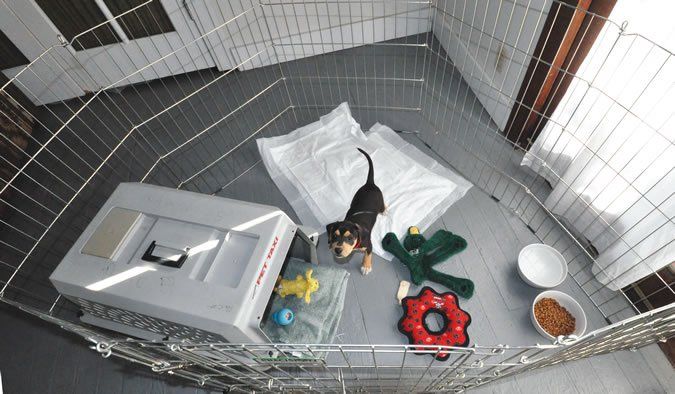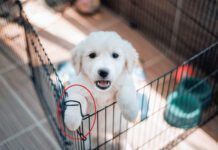It’s one of the best feelings in the whole world — those first few hours with your new puppy when everything is perfect and anything is possible. It doesn’t take long, however, for that bubble to burst. It could be the very first day, when you step in that pile of puppy poo on your Persian carpet, or find deep puppy tooth gouges in your treasured pair of Jimmy Choo shoes. It might be that first night, when you pop your pup into his crate for the first time and crawl into your bed, only to be treated to a few pitiful whimpers, then a chorus of cries, and finally a non-stop serenade of screaming as your pup broadcasts to the world how lost and lonely he is.
The better prepared you are to do things right from the start, the fewer “What have I done?” moments you’ll have, and the more possibilities you and your dog will be able to realize as you travel together through life. Here’s a guide to getting off to the right start with your new pup.
Pre-Puppy Prep
If you would like to prolong that initial warm, fuzzy, oxytocin-rich, “anything is possible” period, set the stage before your puppy’s arrival so you are setting up him, and yourself, for success. One of the basic tenets of positive reinforcement training is that you put in place management measures so your dog can’t find reinforcement for unwanted behaviors. That goes triple for puppies. Put the following management measures in place before you bring your puppy home, and you’ll be miles ahead of the game.
1. Crate.
This will be your puppy’s bedroom. I recommend crating him in your own bedroom so he has the comfort of your presence; it will help to ease the pangs of loneliness he’s likely to feel upon separation from his mom and litter mates. Although you will both be sleeping (I hope), it still gives you valuable time together. It also enables you to hear him so you can take him outside when he wakes up and cries at 4:00 a.m. because he has to potty, until he’s able to hold it all night.
Your pup’s crate should be just large enough for him to comfortably stand up, turn around, and lie down. Some wire crates come with a divider that you can move as the pup grows, to give him only as much space as he needs. Otherwise, plan on getting a series of increasingly larger crates as your pup grows.
2. Exercise Pen.
Like a playpen for a young child, an exercise pen gives your puppy more room than a crate but still keeps him safely confined and out of trouble. You will use the exercise pen if you have to be gone longer during the day than your pup can be expected to “hold it,” as well as times when you are home and can’t supervise him as closely as you would like. Use pee pads or newspapers to create a potty corner in the exercise pen so your pup has a “legal” place to go to the bathroom.
3. Supervision.
Plan on lots of “eyeballs on the pup” time – direct supervision – so you can reinforce desirable behaviors and prevent reinforcement for undesirable ones. You can use the “umbilical-cord approach,” in which you leash the puppy to your person to prevent him from wandering off and getting into trouble, or you can close doors to keep him in the room with you and make sure you keep a very close eye on him so you can intervene as needed.
4. Tether.
Another way to keep your pup close and out of trouble is to tether him in the room with you, so he can share your company without being directly under your feet.
An excellent resource for cable tethers is BADDogsinc Family Dog Training and Behavior (pettethers.com or 951-283-2101). Their cables come in 2-, 3-, 4-, and 6-foot lengths with snaps at both ends for easy securing around the leg of a heavy piece of furniture or clipping to an eyebolt screwed into the wall. They also have lighter-weight tethers for very small dogs, and tethers with a PVC cap attached to one end that you can slide under a door to hold the dog.
5. Puppy-Proofing.
Having a puppy in your home is a lot like having a toddler. He may not be able to stick his fingers into electrical outlets, but he can and will get into everything within reach of his teeth. Puppy-proofing keeps him safe from things like chewing on electrical cords and keeps your valuable possessions safe (like shoes or prescription glasses).
Puppy-proofing also prevents your pup from having the opportunity to learn that undesirable behaviors are fun (reinforcing). You never want him to have the chance to learn, for example, that if he chews up a sofa cushion, he will get to play with the stuffing. Put all your possessions up and away. Keep closet doors closed. Put electrical cords out of reach or, alternatively, run them through PVC pipe. Put baby latches on cupboard doors. Don’t leave food on surfaces that he can reach, lest he learn to counter surf. And supervise, supervise, supervise.
6. House Rules.
Consistency is a linchpin of successful puppy raising. If one family member invites your pup to share the sofa while another yells at him for getting on that piece of furniture, your puppy will be stressed and confused. Sit the family down and agree on house rules before those first puppy paws hit your kitchen floor. It’s fine to let your dog on the furniture if everyone in the household is comfortable with that. Sleeping on someone’s bed is fine if everyone approves. Resolve differences before your pup arrives so he doesn’t suffer from family conflict.
7. Professional Service Providers.
Research and select your pup’s veterinarian, groomer, pet sitter/walker, and training professional well in advance. If you’re scrambling at the last minute, you’re likely to settle for someone who doesn’t necessarily share your philosophies of dog care and handling. If you want to feed raw and take a holistic approach to your dog’s veterinary care, find a veterinarian who will support you in that. If you are committed to positive-based training, find a trainer who not only claims to be positive, but also can define “positive” to your satisfaction. (Some trainers who claim to be positive use shock collars!) Your groomer and veterinarian should allow you to be a full participant in your dog’s procedures, and not insist on whisking him away to a back room. Don’t settle; find the best for your pup.
First Weeks with Puppy
The stage is set. You’re ready for the exciting event. You’re headed to the shelter or rescue facility to pick out a puppy, or to the breeder to pick up the pup you selected long ago. Your first days and weeks with your new pup will greatly influence the next 10 to 15-plus years you share with your new family member. Your goal is to make those the best years possible. Here are some very important pieces of the foundation to make that happen.
Socialization.
Let’s assume you’re adopting an 8-week-old puppy. Five of the dozen or so weeks of his prime socialization period (three weeks to fourteen weeks) are already water under the bridge, so your first assignment is to take full advantage of the remaining six to eight weeks.
In the best of possible worlds, whomever he was with for the first eight weeks took the time to begin the socialization process. If the pup you choose is happy, friendly, and outgoing, you’re on the right road, and you just need to continue normal socialization efforts.
Here’s a pro tip: specifically look for a puppy like this to adopt. If your heart gets the better of you and you fall for the shy puppy hiding in the back of his kennel, you will need to begin work immediately to help your timid puppy learn to be brave. It won’t happen just because you love him, and it won’t be easy. Adopt this puppy only if you are prepared to invest a lot of time and possibly money into doing behavior modification with your pup. (See “Trials of the Timid,” WDJ August 2008.)
The term “socialization” means exposing your puppy to a lot of people, places, and things, and making sure he has good experiences with them. All too often, puppy owners miss the “good experiences” part and end up creating fearful puppies. To avoid this critical mistake, control the environment around your puppy. For example, don’t let your son’s entire soccer team rush up and overwhelm him; do calm, one-at-a-time greetings. Make a commitment to give your puppy at least one new away-from-home positive socialization experience every day.
Housetraining.
Notice we are not “breaking” anything; we are training our puppy to eliminate where we would like him to. To have that happen, you must prevent him from eliminating where you don’t want him to go. This means taking him outside to his designated potty spot more often than he has to go (start with every hour on the hour, then increase the time between potty sessions when he shows you he can hold it longer); waiting with him until he does go; reinforcing the behavior with a click (or “Yes!”) and treat; and then spending some fun time together outside so he doesn’t think eliminating gets punished by going back inside immediately after.
If he doesn’t go potty when you take him out, don’t play; take him back inside and keep him under tight supervision (for example, leashed to you or in his crate) until his next potty break, so he can’t wander off and soil the carpet. (For more information about potty training, see “Potty Time,” June 2013.)
A general rule of thumb is that a puppy can hold it (crated, for example) for about one hour longer than his age in months, so, for example, your two-month-old puppy can possibly be crated for up to three hours at a time. That means at least two trips outside while you are gone during a normal workday. If you can’t arrange for someone to get him outside during the day, keep him in an exercise pen with a bathroom in the corner.
Be prepared to get up at least one time at night, at least for a few weeks. Some pups can hold it longer overnight sooner, because they aren’t as active as they are during the day.
Important note: Do not punish your pup for accidents in the house. If you find one after the fact, it’s far too late to do anything, and you will only frighten your pup if you drag him back to the spot and yell at him. If you throw a fit when you “catch him in the act,” you will teach him to go eliminate where you can’t see him. Simply interrupt him with a gentle “Oops, outside!” and take him out to the proper spot to potty. Reward him if he resumes his “business” in the right place.
Training.
You will have already located the positive-training professional with whom you would like to work. Get your pup into a puppy training and socialization class as soon as possible.
Some veterinarians unfortunately still advise owners to wait until their pup is fully immunized to attend class, but those vets are far behind the times. (See “Veterinary Behaviorists Agree: Get That Puppy into a Class,” on right.)
A good puppy-class instructor can help guide you through the challenges of house-training, puppy chewing, mouthing, and other baby-dog issues, as well as offer a well-managed venue for socialization with other puppies and humans. Additionally, she will help you teach your pup his basic good-manners behaviors, such as sit, down, walk politely on leash, come when called, and much more. This is the foundation of your pup’s education, and will open the door to a fascinating array of training options that could include rally, agility, scent work, herding, dock diving, Treibball, and much, much more.
Whether you train with a clicker or not, make a commitment to use force-free training and handling methods with your dog throughout his life. If any training professional tries to convince you that pain and coercion are necessary components of training, or that “electronic” (shock) collars don’t hurt, run away fast. You are your dog’s advocate and protector; don’t let him down. He will thank you for it.
Pat Miller, CBCC-KA, CPDT-KA, is WDJ’s Training Editor. She lives in Fairplay, Maryland, site of her Peaceable Paws training center, where she offers dog-training classes and courses for trainers.






